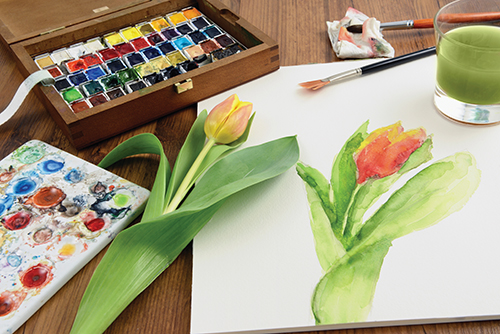Suicide prevention is always important, but an extra emphasis is placed on this topic each September during Suicide Prevention Awareness Month.
For veterans who struggle with thoughts of suicide, the creative arts are often used to help. Art therapy has been around for a long time, and over the past decade, the U.S. Department of Veterans Affairs has worked hard to employ more creative arts therapists.
Nadene Stillings has been working as an art therapist since 2005 and has been at the U.S. Bedford Medical Center in Massachusetts since 2010. She is also a U.S. Army veteran.
 “We use the arts to explore coping strategies because they are so new and raw in their treatment,” she said. “It provides them the opportunity to process what brought them to that point. They don’t have to talk about their feelings — art becomes that catalyst for conversations after.”
“We use the arts to explore coping strategies because they are so new and raw in their treatment,” she said. “It provides them the opportunity to process what brought them to that point. They don’t have to talk about their feelings — art becomes that catalyst for conversations after.”
According to the U.S. Department of Veterans Affairs, art therapists use art media, the veteran’s creativity, and the resulting artwork to assist veterans with introspection to reconcile emotional conflicts, foster self-awareness, manage behavior and addictions, develop social skills, reduce anxiety, and increase self-esteem.
“The beautiful thing about art therapists is our master’s level training knows how to elicit and positively use art in the therapy to meet the specific therapeutic goals of the veteran,” she said.
Working with veterans, Stillings helps guide the process for the veteran who is looking and learning from the art.
“There is meaningful healing that happens in the creative process,” she said. “Art therapy is based on clinical therapeutic goals that are set with the treatment team.”
In addition to the art therapist, veterans work with a whole team, such as a psychologist and social worker, who help determine the goals for the veteran, who also has a say in what their goals are for therapy.
Stillings has veterans come in all the time who don’t want to create any art or say they aren’t an artist.
“It’s not about the product when it comes to art therapy,” she said. “If you make something you’re proud of, great. It’s about the process.”
Many who come to therapy now are veterans who were in the military, then the workforce, then volunteers, and then COVID-19 hit — so veterans are in this crisis of being unsure what the purpose of their life is.
“A big part is learning trust, building acceptance, and finding meaning in your life — finding that purpose,” Stillings said.
Group therapy can help with this as it provides a place to bounce ideas off of each other and can help them not feel isolated.
“A big part of suicide prevention is building community,” she said.
For those who may be thinking of suicide, art therapy can help through improving cognitive skills, self-awareness, and it’s used to build emotional resilience.
“[Art therapy] doesn’t feel as difficult as it would be when sitting with a psychologist staring back at you,” Stillings said.
Although an art therapist, she also runs a creative writing group, which has been successful in helping veterans work through their suicidal thoughts.
“It gets the feelings out of the body through creative writing,” she said. “Journaling is one of the most impactful processes we’ve done for our folks here. For some of them, just the fact that they are sitting down doing something for them puts them on a better path. I think that’s the biggest thing.”
Reminding them of their sense of purpose can be a great blocker for their thoughts of suicide. Along with this, positive affirmations can be very helpful. Stillings recommends starting every day by saying one kind thing to yourself and putting it on a Post-it note so you can regularly see it.
“For some veterans, I have them put it on the ceiling above their bed so it’s the first thing they see when they wake up,” she said. “They are gentle reminders that become engrained.”
Veterans who want to learn more about how art therapy can help with thoughts of suicide, PTSD, and more are encouraged to contact their local VA to connect with an art therapist.
Helpful information for those struggling with thoughts of suicide
The warning signs of suicide, according to the National Alliance on Mental Illness:
In the spirit of Service, Not Self, the mission of the American Legion Auxiliary is to support The American Legion and to honor the sacrifice of those who serve by enhancing the lives of our veterans, military, and their families, both at home and abroad. For God and Country, we advocate for veterans, educate our citizens, mentor youth, and promote patriotism, good citizenship, peace and security.